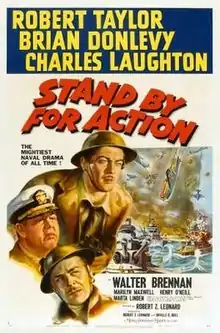Stand By for Action
Stand By for Action (British title: Cargo of Innocents) is a 1942 American war film directed by Robert Z. Leonard, starring Robert Taylor, Brian Donlevy, Charles Laughton, Walter Brennan, and, in her film debut, Marilyn Maxwell. Suggested by a story by Laurence Kirk, and with an original story by Captain Harvey Haislip and R. C. Sherriff, the film's screenplay was written by George Bruce, John L. Balderston, and Herman J. Mankiewicz.
| Stand By for Action | |
|---|---|
 | |
| Directed by | Robert Z. Leonard |
| Produced by | Orville O. Dull Robert Z. Leonard |
| Screenplay by | George Bruce John L. Balderston Herman J. Mankiewicz |
| Story by | Laurence Kirk Harvey S. Haislip R. C. Sherriff |
| Starring | Robert Taylor Brian Donlevy Charles Laughton |
| Music by | Lennie Hayton |
| Cinematography | Charles Rosher |
| Edited by | George Boemler |
Production company | |
Release date |
|
Running time | 109 minutes |
| Country | United States |
| Language | English |
| Budget | $1.4 million[1] |
| Box office | $3.2 million[1] |
Plot
During World War II, well-connected, Harvard-educated Lieutenant Gregg Masterman (Robert Taylor) enjoys his cushy posting as junior aide to Rear Admiral Stephen "Old Ironpants" Thomas (Charles Laughton), playing tennis and arranging social events. During a chance encounter, he gives bad advice to up-from-the-ranks Lieutenant Commander Martin J. Roberts (Brian Donlevy) out of spite. As a result, Thomas gives Roberts command of an obsolete, World War I-vintage destroyer, the Warren. To his dismay, however, Masterman finds himself assigned by Thomas as Roberts' new executive officer. When Masterman learns that Henry Johnson (Walter Brennan), the ship's civilian caretaker, was a member of the Warren's original crew, he helps him reenlist and serve aboard his beloved ship.
Despite his awkward beginning, Masterman begins to turn into an effective officer under Roberts' tutelage, though Roberts has to constantly remind him that he cannot put the welfare of one person over that of the mission. On their way to rendezvous with a convoy commanded by Thomas, they are attacked by a Japanese airplane. Then, Johnson sustains a serious head injury during a storm, leaving him delirious and believing he is back in World War I. Finally, they rescue two pregnant women and 20 babies, survivors of a torpedoed ship. For comic relief, the crewmen (especially Masterman) have to deal with their unusual passengers. One woman gives birth just before they sight the convoy.
An aircraft hit cripples Thomas's flagship, damaging the steering mechanism. Thus, when a Japanese battleship sights the convoy, it is all up to the Warren. Roberts informs Masterman of his plan of attack. He intends to set up a smoke screen, hide behind it, and then emerge to launch a torpedo salvo. When the captain is injured, Masterman assumes command. During the battle, Johnson takes over the helm when a crewman is knocked out. It takes two attempts, but the Warren sinks the enemy.
Cast
- Robert Taylor as Lieutenant Gregg Masterman
- Charles Laughton as Rear Admiral Stephen Thomas
- Brian Donlevy as Lieutenant Commander Martin J. Roberts
- Walter Brennan as Chief Yeoman Henry Johnson
- Marilyn Maxwell as Audrey Carr
- Henry O'Neill as Commander Stone M.C.
- Marta Linden as Mary Collins
- Chill Wills as Chief Boatswain's Mate Jenks
- Douglass Dumbrille as Captain Ludlow
Cast notes
- Singer Marilyn Maxwell made her screen debut in Stand By for Action.[2]
Production
A number of titles were considered for the film which became Stand By for Action, including Cargo of Innocence – the name under which the film was released in the United Kingdom, A Cargo of Innocents, Men O'War, Clear for Action, Navy Convoy, This Man's Navy, and Pacific Task Force.[3] Although the film was shot in Hollywood, it was originally scheduled to be filmed in late 1941 at the MGM studio in England, with Clarence Brown directing Robert Donat and Edmund Gwenn, but production was shifted to California because of the war situation.[3] The original intention was that the film would be about the Royal Navy in the Atlantic Ocean, but after the U.S. entered the war, the story was changed to focus on the U.S. Navy in the Pacific, the first naval war film made by MGM.[3]
Release
The film premiered on New Year's Eve 1941 in a number of cities, including Boston, Providence, Rhode Island, Washington, D.C., Chicago, Norfolk, Virginia, San Diego, California, and San Francisco,[4] but MGM had previously screened the film for naval officers on bases in California.[3]
Response
Critical response
The critical response to the film was not good, with the reviewer for Yank magazine saying that the film was "not about The War, but about Hollywood's War," and other reviewers comparing it to In Which We Serve, the 1942 British naval film written by and starring Noël Coward and directed by Coward and David Lean, with the earlier film being deemed superior.[3] Bosley Crowther, the film critic for The New York Times, thought that Charles Laughton's performance was not his best, an opinion that Laughton himself agreed with, saying that it was like something out of H.M.S. Pinafore.[2]
Awards and honors
The film was nominated for the Oscar for Best Special Effects (A. Arnold Gillespie, Donald Jahraus, Michael Steinore).[6]
References
- The Eddie Mannix Ledger, Los Angeles: Margaret Herrick Library, Center for Motion Picture Study.
- Nixon, Rob. "Stand By for Action" on TCM.com
- "Notes" on TCM.com
- "Overview" on TCM.com
- "Top Grossers of the Season", Variety, 5 January 1944 p 54
- "The 16th Academy Awards (1944) Nominees and Winners". oscars.org. Retrieved 2013-06-23.
External links
| Wikimedia Commons has media related to Stand By for Action (film). |